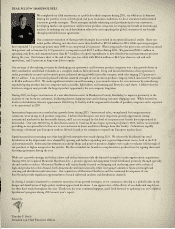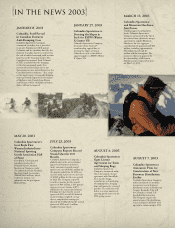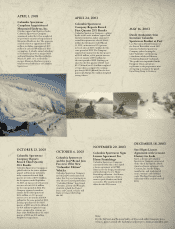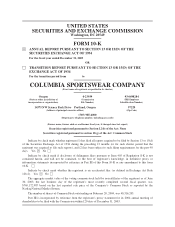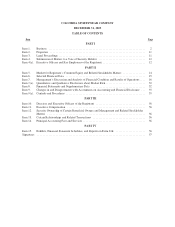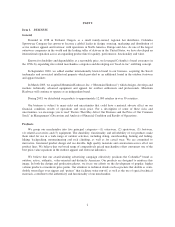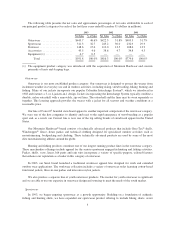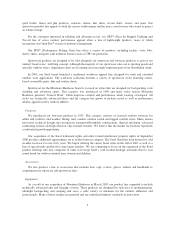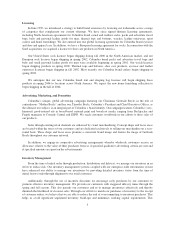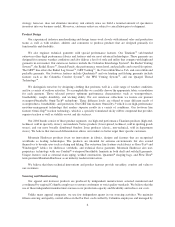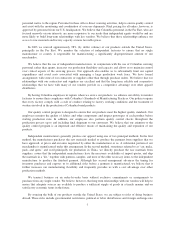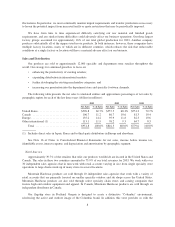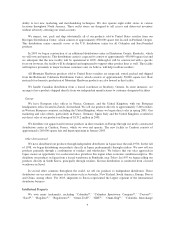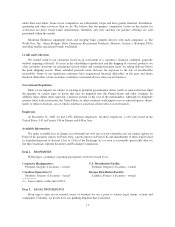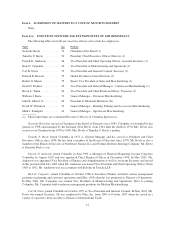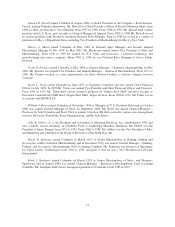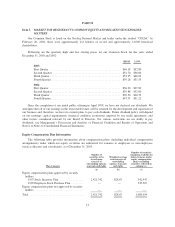Columbia Sportswear 2003 Annual Report Download - page 12
Download and view the complete annual report
Please find page 12 of the 2003 Columbia Sportswear annual report below. You can navigate through the pages in the report by either clicking on the pages listed below, or by using the keyword search tool below to find specific information within the annual report.personnel native to the region. Personnel in these offices direct sourcing activities, help to ensure quality control
and assist with the monitoring and coordination of overseas shipments. Final pricing for all orders, however, is
approved by personnel from our U.S. headquarters. We believe that Columbia personnel in the Far East, who are
focused narrowly on our interests, are more responsive to our needs than independent agents would be and are
more likely to build long-term relationships with key vendors. We believe that these relationships enhance our
access to raw materials and factory capacity at more favorable prices.
In 2003 we sourced approximately 98% (by dollar volume) of our products outside the United States,
principally in the Far East. We monitor the selection of independent factories to ensure that no single
manufacturer or country is responsible for manufacturing a significantly disproportionate amount of our
merchandise.
We believe that the use of independent manufacturers, in conjunction with the use of Columbia sourcing
personnel rather than agents, increases our production flexibility and capacity and allows us to maintain control
over critical aspects of the sourcing process. Our approach also enables us to substantially limit our capital
expenditures and avoid costs associated with managing a large production work force. We have formal
arrangements with some of our contractors or suppliers other than through purchase orders. We believe that our
relationships with our contractors and suppliers are excellent and that the long-term, reliable and cooperative
relationships that we have with many of our vendors provide us a competitive advantage over other apparel
distributors.
By having Columbia employees in regions where we source our products, we enhance our ability to monitor
factories to ensure their compliance with Columbia’s Standards of Manufacturing Practices. Our policies require
that every factory comply with a code of conduct relating to factory working conditions and the treatment of
workers involved in the production of Columbia brand products.
Our quality control program is designed to ensure that our products meet the highest quality standards. Our
employees monitor the quality of fabrics and other components and inspect prototypes of each product before
starting production runs. In addition, our employees also perform quality control checks throughout the
production process up to and including final shipment to our customers. We believe that our attention to the
quality control program is an important and effective means of maintaining the quality and reputation of our
products.
Independent manufacturers generally produce our apparel using one of two principal methods. In the first
method, the manufacturer purchases the raw materials needed to produce the garment from suppliers that we
have approved, at prices and on terms negotiated by either the manufacturer or us. A substantial portion of our
merchandise is manufactured under this arrangement. In the second method, sometimes referred to as “cut, make,
pack, and quota” and used principally for production in China, we directly purchase the raw materials from
suppliers, assure that the independent manufacturers have the necessary availability of import quotas, and ship
the materials in a “kit,” together with patterns, samples, and most of the other necessary items, to the independent
manufacturer to produce the finished garment. Although this second arrangement advances the timing for
inventory purchases and exposes us to additional risks before a garment is manufactured, we believe that it
further increases our manufacturing flexibility and frequently provides us with a cost advantage over other
production methods.
We transact business on an order-by-order basis without exclusive commitments or arrangements to
purchase from any single vendor. We believe, however, that long term relationships with our vendors will help to
ensure that adequate sources are available to produce a sufficient supply of goods in a timely manner and on
satisfactory economic terms in the future.
By sourcing the bulk of our products outside the United States, we are subject to risks of doing business
abroad. These risks include governmental restrictions, political or labor disturbances and foreign exchange rate
7


